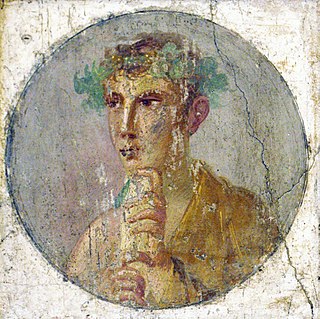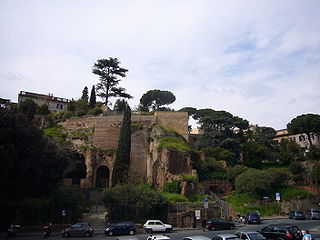
The cursus honorum was the sequential order of public offices held by aspiring politicians in both the Roman Republic and the early Roman Empire. It was designed for men of senatorial rank. The cursus honorum comprised a mixture of military and political administration posts. Each office had a minimum age for election. There were minimum intervals between holding successive offices and laws forbade repeating an office.

Roman law is the legal system of ancient Rome, including the legal developments spanning over a thousand years of jurisprudence, from the Twelve Tables, to the Corpus Juris Civilis ordered by Eastern Roman Emperor Justinian I. Roman law forms the basic framework for civil law, the most widely used legal system today, and the terms are sometimes used synonymously. The historical importance of Roman law is reflected by the continued use of Latin legal terminology in many legal systems influenced by it, including common law.

The Roman Forum, also known by its Latin name Forum Romanum, is a rectangular forum (plaza) surrounded by the ruins of several important ancient government buildings at the center of the city of Rome. Citizens of the ancient city referred to this space, originally a marketplace, as the Forum Magnum, or simply the Forum.

The Rostra was a large platform built in the city of Rome that stood during the republican and imperial periods. Speakers would stand on the rostra and face the north side of the comitium towards the senate house and deliver orations to those assembled in between. It is often referred to as a suggestus or tribunal, the first form of which dates back to the Roman Kingdom, the Vulcanal.
During the Roman Republic, nobilis was a descriptive term of social rank, usually indicating that a member of the family had achieved the consulship. Those who belonged to the hereditary patrician families were noble, but plebeians whose ancestors were consuls were also considered nobiles. The transition to nobilitas thus required the rise of a non-noble individual to the consulship, who was considered a "new man". Two of the most famous examples of these self-made "new men" were Gaius Marius, who held the consulship seven times, and Marcus Tullius Cicero.
A bench trial is a trial by judge, as opposed to a trial by jury. The term applies most appropriately to any administrative hearing in relation to a summary offense to distinguish the type of trial. Many legal systems use bench trials for most or all cases or for certain types of cases.

Citizenship in ancient Rome was a privileged political and legal status afforded to free individuals with respect to laws, property, and governance.

Senatus consultum ultimum, more properly senatus consultum de re publica defendenda is the modern term given to a decree of the Roman Senate during the late Roman Republic passed in times of emergency. The form was usually consules darent operam ne quid detrimenti res publica caperet or videant consules ne quid res publica detrimenti capiat. It was first officially decreed prior to the fall of Gaius Gracchus in 121 BC, and subsequently at several other points, including during Lepidus' march on Rome in 77 BC, the Conspiracy of Catiline in 63 BC, and before Julius Caesar crossed the Rubicon in 49 BC. The senatus consultum ultimum effectively replaced the disused dictatorship, by removing limitations on the magistrates' powers to preserve the state. After the rise of the Principate, there was little need for the Senate to issue the decree again.

The Curiate Assembly was the principal assembly during the first two decades of the Roman Republic. During these first decades, the People of Rome were organized into thirty units called "Curiae". The Curiae were ethnic in nature, and thus were organized on the basis of the early Roman family, or, more specifically, on the basis of the thirty original Patrician (aristocratic) clans. The Curiae formed an assembly for legislative, electoral, and judicial purposes. The Curiate Assembly passed laws, elected Consuls, and tried judicial cases. Consuls always presided over the assembly. While Plebeians (commoners) could participate in this assembly, only the Patricians could vote.
The lex Hortensia, also sometimes referred to as the Hortensian law, was a law passed in Ancient Rome in 287 BC which made all resolutions passed by the Plebeian Council, known as plebiscita, binding on all citizens. It was passed by the dictator Quintus Hortensius in a compromise to bring the plebeians back from their secession to the Janiculum.

In Roman law, status describes a person's legal status. The individual could be a Roman citizen, unlike foreigners; or he could be free, unlike slaves; or he could have a certain position in a Roman family either as head of the family, or as a lower member.
Secessio plebis was an informal exercise of power by Rome's plebeian citizens, similar to a general strike taken to the extreme. During a secessio plebis, the plebs would simply abandon the city en masse and leave the patrician order to themselves. Therefore, a secessio meant that all shops and workshops would shut down and commercial transactions would largely cease. This was an effective strategy in the Conflict of the Orders due to strength in numbers; plebeian citizens made up the vast majority of Rome's populace and produced most of its food and resources, while a patrician citizen was a member of the minority upper class, the equivalent of the landed gentry of later times. Authors report different numbers for how many secessions there were. Cary & Scullard state there were five between 494 BC and 287 BC.

The crisis of the Roman Republic refers to an extended period of political instability and social unrest that culminated in the demise of the Roman Republic and the advent of the Roman Empire, from about 134 BC to 44 BC.

A tribus, or tribe, was a division of the Roman people, constituting the voting units of a legislative assembly of the Roman Republic. The word is probably derived from tribuere, to divide or distribute; the traditional derivation from tres, three, is doubtful.

The constitution of the Roman Republic was a set of unwritten norms and customs, which together with various written laws, guided the manner by which the Roman Republic was governed. The constitution emerged from that of the Roman kingdom, evolved over the almost five hundred years of the Republic, and was transformed into the constitution of the Roman Empire.

A fetial was a type of priest in Ancient Rome. They formed a collegium devoted to Jupiter as the patron of good faith.

In Roman constitutional law, rogatio is the term for a legislative bill placed before an Assembly of the People in ancient Rome. The rogatio procedure underscores the fact that the Roman senate could issue decrees, but was not a legislative or parliamentarian body. Only the People could pass legislation.
Titus Quinctius Capitolinus Barbatus was a Roman statesman and general who served as consul six times. Titus Quinctius was a member of the gens Quinctia, one of the oldest patrician families in Rome.








